Brian and I got there early and went looking for Pinnacle Cave. Since I forgot to bring the coordinates with me, we went from my memory... in other words, we couldn't find it. We followed the limestone outcrops along the ridge for a bit and found several interesting spots that could use some digging.
Our group of 12 cavers suited up, descended the entrance slot, and met up in the first big room. Brian brought three slave flash units, so we spent a lot of time setting up and taking photos in this cave. We took some more photos in Halloween Hall, then headed over the breakdown area to the left and went to the mud sculpture room where we rested for a bit.

A nice group photo in the entrance room

Checking out the mud sculptures
Afterwards, we headed below to the stream passage and walked upstream to the double waterfall, which was moving a good bit of water. We took some more photos, and a few people went up the lefthand stream tunnel to check it out. The group headed back downstream, and eventually back to Halloween Hall... for some more photos.

Climbing Sharps waterfall
Since it was still early, we decided to check out the other half of the cave. We dropped down into the canyon passage to the right of Halloween Hall. This passage is an abandoned stream passage, but shortly exposes in a few small pits where the active stream is flowing directly beneath it. The stream flows from here, under the canyon passage, and eventually reappears as the top stream at the waterfall. Moving forward, you are eventually walking in the stream, but it's mostly dry travel.
After about 15 minutes, the passage opens up into a large room, Catfish Hall. As I cleared the breakdown and looked up into it, I saw a dozen lights pointed at me - I was completely surprised and couldn't figure out how our entire party had passed me and was now staring at me from the next room. It turned out to be the Pittsburgh Grotto, 11 strong, waiting there to surprise us! We mingled for a few minutes, then couldn't turn down the chance for another photo.

We're a happy family - Mon Grotto, Pittsburgh Grotto meet underground
The Pittsburgh group headed back the way we'd just come, and some of our party headed out of the cave. The rest went forward, over some more very large breakdown, to find another impressively-sized room, the Z Room. Brian and I stayed here to take some more photos, while Doug and the remainder of the group explored for a bit beyond.

Lighting up the last big room
We headed back out, exited the cave to find daylight and very nice weather waiting for us.
All photos by Brian Masney
Alternate trip report: Doug McCarty, Additional photos: Mon Grotto Sharps page








